SELECTION OF QUESTIONS AND ANSWERS
OCTOBER 2012 PART 1
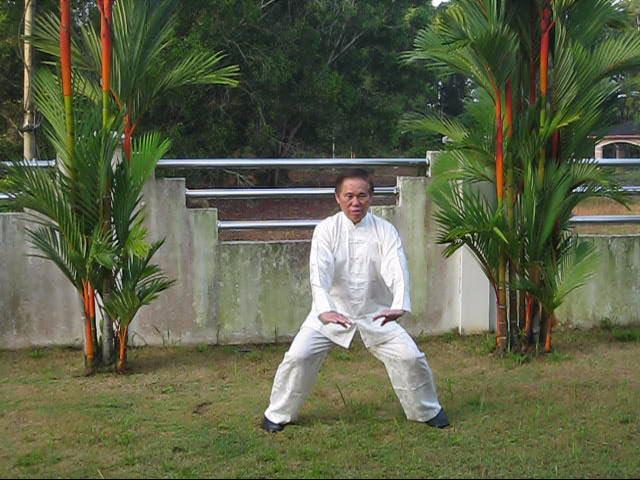
San Zhan of Wuzuquan
Question 1
Sifu,
What special memories you have about your learning Wuzuquan from Sigung Chee Kim Tong?
— Sifu Mark Appleford, Chief Instructor , Shaolin Wahnam UK
Answer
While Sifu Chee Kim Thong, regarded as the living treasure of China, was officially my teacher, the teaching was carried out by his eldest son, Siheng Chee Boon Leong, at Sifu Chee Kim Thong's house in Dungun, Trengganu. Sifu Chee Kim Thong usually spent his time in Kuala Lumpur.
What I remember most about my learning Wuzuquan was my siheng often telling me "mm meng yong lak", which is the Hokkian dialect of saying, "Don't use strength".
This puzzled me because earlier when I learned from Uncle Righteousness in Penang, my sifu often asked us to "yoong lek, yoong lek", which is the Cantonese dialect of saying "Use strength, use strength!"
I remember thinking how could one fight effectively if he didn't use strength. But when I sparred with my seniors, I found them very powerful. They did not use strength; they used internal force.
It was my first taste of internal force at the receiving end. If I had any doubt earlier, it absolutely convinced me that internal force was real, and that there was no need to use any muscular strength.
I also clearly remember asking my seniors, "How come you are so powerful?"
"Use internal force!" they said.
"How did you have so much internal force?"
"Practice San Zhan."
"I practice San Zhan," I said, "but I have no internal force."
My seniors thought for awhile. Then one of them said, "Perhaps you haven't trained Abdominal Breathing."
"Please teach me Abdominal Breathing," I besought them.
"Teach you Abdominal Breathing? You must be joking!"
"No joking"
"No, sifu will skin us."
But, due to my earnest entreaty, they eventually showed me, not taught me, Abdominal Breathing.
That was enough. I was a fast and smart learner. I could learn quickly by just watching.
Although I performed the techniques of Abdominal Breathing well, I did not have internal force. It was much later when I looked back that I knew I did not have the skills though I knew the techniques.
Years later when I learned One-Finger Shooting Zen from Sifu Ho Fatt Nam, I developed internal force. I also learned Abdominal Breathing from Sifu Ho Fatt Nam as part of my Small Universe training.
Question 2
What special features are taught in the Wuzuquan Course in December? Is the course recommended for those who have not learnt Wuzuquan before or who may not want to specialize in Wuzuquan?
Answer
Befitting its name as a special course, the Wuzuquan Course is special in many ways.
Wuzuquan, especially the Wuzuquan of Sifu Chee Kim Thong, is famous for internal force. Many martial artists would have heard of this story. A journalist for an international martial art magazine met Sifu Chee Kim Thong for an interview.
The journalist was a Karate black-belt, had trained Iron Palm and was well known for breaking bricks. He asked Sifu Chee Kim Thong to demonstrate his internal force. Sifu Chee Kim Thong sat in a lotus position and asked the journalist to chop hard at his head. At first he did so gently, but eventually he chopped really hard at Sifu Chee Kim Thong's head and nearly broke his palm.
Internal force in Wuzuquan is trained by practicing its fundamental kungfu set, San Zhan, and Abdominal Breathing. It is unbelievable but true that it took me many years to develop internal force but participants at the Wuzuquan Course will develop internal force through San Zhan and Abdominal Breathing in just a few days!
When I first practiced San Zhan I did not know how to use its patterns for combat. If an opponent gave me a kick, attempted to fell me to the ground, or gripped my arm, I did not know how to defend against these attacks. I believe many Wuzuquan practitioners today are in a similar situation.
Like many Wuzuquan practitioners, I thought that San Zhan was just for developing internal force, although at the time I practiced it for two years I had no internal force. But now I realize that San Zhan itself is complete, and its patterns can counter any attacks, regardless of whatever they are strikes, kicks, felling or gripping!
Except, perhaps, if a Wuzuquan practitioner is already being pinned down by a heavy-weight. But a Wuzuquan practitioner would not allow this to happen. He has enough counters against any opponents trying to fell him before pinning him down.
But what would you do if an opponent succeeded in pinning you down? We shall borrow two techniques from the Drunken Eight Immortals to teach in the Wuzuquan Course. So even if a course participant is being pinned down by a heavy-weight, he would be able to flip the heavy-weight away, especially when he has developed some internal force.
San Zhan of Wuzuquan is an excellent example of profundity in simplicity. It looks so simple, but is sufficient to handle any attack! Once a course participant is able to apply patterns from San Zhan for combat, applying patterns from other kungfu sets would be relatively easy. A special benefit is that even when he has not learnt a particular martial art set before, but by watching its performance he would know how to apply its patterns for combat.
Another special feature of the course is to exhibit as well as face threat, especially in free sparring against other martial artists. Having an element of threat is an important part of efficient combat, but it happens to be a weakness amongst many of our students and some instructors. This course will overcome this weakness.
It is indeed interesting that when I first learned Wuzuquan, because of my own ignorance I found it inadequate for combat. But after my "enlightenment" in combat application after learning from Sifu Ho Fatt Nam, not only I could apply Wuzuquan for combat, I could teach it as an effective tool to win free sparring competitions. It took me 30 years to arrive at this point. Course participants at the Wuzuquan Course will gain in a few days what it took me 30 years to develop.
Hence, I would strongly recommend this Wuzuquan Course to all, irrespective of whether they have learnt Wuzuquan before or intend to specialize in Wuzuquan.
Amongst other benefits, they will develop tremendous internal force. If they already has internal force, this course will make their internal force more fluid and powerful.
It will teach them combat applications of patterns where combat application appears impossible. They shall find it so easy to counter sophisticated attacks once they understand some combat principles which are specially significant in Wuzuquan patterns because the patterns are so simple.
If the course participants are ready, they may have an aha experience discovering the root principle of all counters which can be used against all attacks! I would let course participants to have the fun of finding out this root principle at the course.
The Wuzuquan Course will also enable course participants to exhibit as well as face threat, which is a common weakness amongst many of our students and some instructors. Our students can apply their combat application effectively when sparring amongst themselves, but when sparring with martial artists of other schools, our students lose heir composure when their opponents become threatening.
Our students are beaten by other martial artists even when our students are superior in martial art training because our students throw away what they have trained and fight like their opponents. The Wuzuquan course will overcome this weakness.
Editorial Note
: Grandmaster Wong will conduct a Special Wuzuquan Course from 11th to 17th December 2012. Please see the
home page
for details.
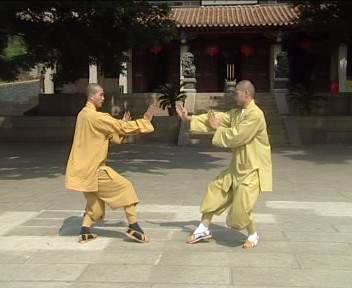
Wuzuquan sparring
Question 3
I often feel the pain and illness of my patients. When I treat a patient with back pain, for example, I can feel the back pain in me. When I treat a patient with asthma, I have breathing difficulties. Is there anything in chi kung that I can do to help me?
— Dr Alejandra, Mexico
Answer
In chi kung terms, this is called "resonance". You resonate with or pick up the feelings or suffering of your patients. As you are a doctor, this special ability is not very pleasant. But fortunately there are ways in chi kung to deal with it.
One effective way is to build a protective energy shield between you and your patient. This can be easily done. You can do it physically or mentally, or both.
Move your two palms in front of you to create an energy wall. Or you can stand at a side and move one arm down as if chopping to create the wall. These physical movements may look weir in front of your patients. Thus, it may be more suitable to use your mind.
Go into a chi kung state of mind, and gently think of an energy shield between you and your patient.
Irrespective of whether you use your palms, arm or mind to create the energy shield, having created it, just have a gentle thought that negative energy from the patient, including his pain and emotions, will be bounced of by the energy shield.
Another effective way is to generate a gentle energy flow inside you. If you have learnt the Small Universe or Cosmic Shower, they will be very useful. Otherwise, any gentle energy flow will do.
Have a gentle thought that negative energy from your patients is deflected away by your energy flow.
Question 4
In practicing the sequences and sets, do I have to practice them in slow motion or use speed and strength?
— Hussain, Saudi Arabia
Answer
One can practice the sequences and sets in many ways depending on his developmental stage and the purpose of his training.
A good guide is the following procedure: form - force - speed.
Regarding developmental stages, at the beginning a student should focus on picture-perfect form, without paying much attention to force and speed. It will be helpful for him to perform the sequences and sets slowly so that he can perfect transitional movement and established form.
At the intermediate stage, when his form is picture perfect, he can focus on exploding force. He must do so without sacrificing his form. His movement can be carried out in normal speed.
At the advanced stage when his form is picture perfect and his force is good, he should focus on increasing his speed, without sacrificing his form and force. Eventually he can perform his sequences and sets with picture perfect form, good force and fast speed, yet without being tired or panting for breaths.
When he is quite advanced in his training, he can vary his force and speed according to the purpose of his practice. If he is practicing for combat efficiency, he should perform his sequences and sets with picture perfect form, good force and fast speed.
If he wants to appreciate the movement of his kungfu or to generate a chi flow, he should perform the sequences and sets slowly and gracefully. If he wishes to increase his force, he can first perform the movement slowly to initiate his chi flow, then increase his speed to increase his force.
As you are quite advanced in your kungfu development, you can choose the appropriate speed and force levels to suit your particular purpose of that practice session. On the other hand, when you learn a new sequence or set, you should adjust your speed and force according to your learning stage.
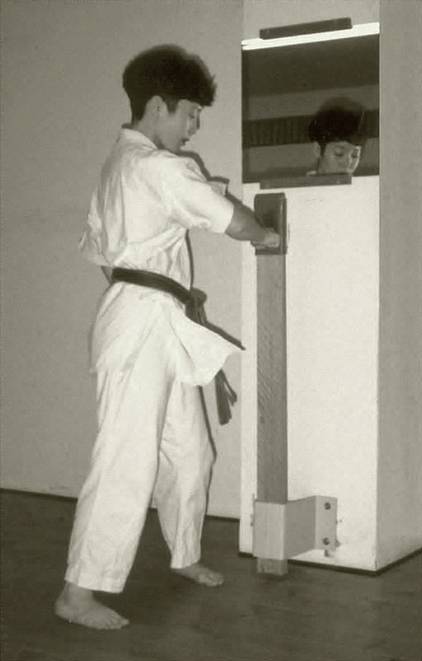
A martial artist punching a wakiwara. Photo provided by Hussain
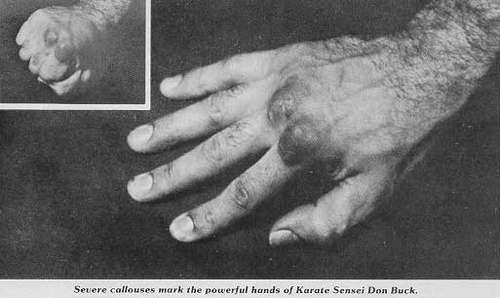
The hand of a makiwara practitioner. Photo provided by Hussain
Question 5
I have a question about a karate exercise called makiwara. This exercise is used to strengthen the fist by punching a rope wrapped wooden pole or pad. Is there any psychological impact on the practitioner caused by this exercise?
Answer
Yes, there is psychological impact besides the physiological harm obviously shown in the photograph you have provided.
First I shall talk about the physiolgical harm before going to the psychological impact. The harm is not just at the hand but has far-reaching adverse effects on other parts of the body, a fact many makiwara practitioners many not know.
The hand is linked by meridians, or pathways of energy flow, from the heart, the pericardium and the lungs, and to the small intestines, the triple-warmer and the colon. (The triple-warmer refers to the internal three sections of a person's trunk, and is regarded in Chinese medical philosophy as an internal organ.) The meridian system also links these organs to all part of the body.
As a practitioner habitually punches a makiwara over a prolonged period, the re-bouncing force from the punches send shock waves back to these organs, harming them. These shock waves also affect the eyes. If you observe makiwara practitioners you will notice that their eyes lack lustre.
In Chinese medical philosophy, the organs are directly related to emotions. When a person's heart is injured, he loses the ability to experience joy. When his lungs are injured, he is more prone to depression.
The heart is also related to the intellect and the spirit. Hence, when a person has injured his heart, he will be less intelligent and lower in spirit than when he is healthy.
In my young days, I went looking for karate and taekwondo backbelts for free sparring. Many of them had deformed their hands through makiwara training. Yet, despite their dedicated makiwara training, their hits were not very powerful. There was a joke that karate practitioners broke planks in their demonstrations, whereas kungfu practitioners broke bricks.
Do you know why makiwara training does not develop a lot of force? Actually not many makiwara practitioners know this.
When you punch a makiwara, you condition you fist, enabling you to endure pain better when you punch an opponent or a hard object. It does not increase your force. In fact, the pain caused by the makiwara makes you withdraw your punch, thus interrupting the flow of force. You might have developed more force by punching into empty space.
Question 6
How do we practice exercises from the Eighteen-Lohan Art?
— Alberto, Spain
Answer
Practice the Eighteen-Lohan Art exercises, or any exercises, the way you have been taught. This is only logical.
Do not practice them the way you think they should be practiced. This, in fact, is a very common mistake made by many students. Although they may not mean it, they think they are smarter than their teachers.
Their teachers ask them to practice for about 15 minutes a session, two sessions a day. They practice for half an hour whenever they like.
Their teachers ask them not to think of any thing while practicing. They start to intellectualize from start to end.
But of course the students must first of all make sure that the teachers are competent. Competent teachers in chi kung and kungfu are a rare bred today. When they have found a competent teacher, just follow his instructions respectfully.
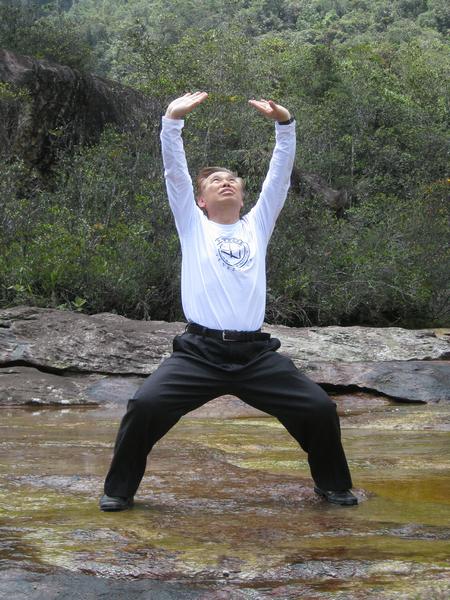
Big Boss Lifts Bronze Vessel is a powerful exercise. How do we know if we over-train? We know from direct experience.
Question 7
Can we combine the exercises?
Answer
Yes, you can combine the exercises in the Eighteen-Lohan Art, and in any order. You can also combine Eighteen-Lohan Art exercises with exercises from the Eighteen Lohan Hands, or with exercises from any other form of chi kung, provided that you do not over-train.
For example, you may perform Worshiping Buddha, followed by Big Bird Flaps Wings. Or you may start with Old Monk Takes off Shoes, followed by Lifting the Sky and Immortal Wipes Eyes.
Irrespective of whether you perform just one or more exercises, your training session should be about 10 to 15 minutes. If you perform more exercises, you have to adjust your speed or number of repetitions.
Question 8
How do we ensure that our practice is not too powerful?
Answer
In principle it is like asking how you know you do not over-eat.
In both cases, you know from direct experience. When you feel that you have eaten enough, you stop eating even when you like the food. When you feel you have practiced enough, you stop practicing.
Initially when you do not have much experience, your estimation may not be correct. You may over-eat or over-train, and in both cases you feel uncomfortable. So long as you do not over-eat or over-train often, any adverse effects will heal by themselves. The uncomfortable feeling is a warning signal that you should stop.
If you still feel uncomfortable, a gentle chi flow is a good remedy for both over-eating and over-training.
LINKS
Selected Reading
- Is it Necessary to Attend Special Courses?
- The Chameleon
- Yang Top Bottom Ying
- Platinum Kungfu
- We Have Been Blessed
